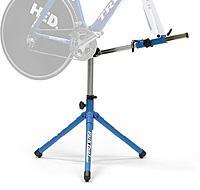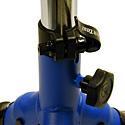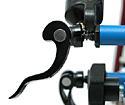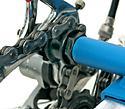
Recently on Cyclingnews.com |
On test: Park Tool PRS-20 workstand, May 18, 2005
Everything old is new again
A modern incarnation of the traditional European style of pro race workstand, Park Tool's PRS-20 solves the problem of the damage a frame clamp can do to ultra-light frame materials. Steven A Marks is impressed.

|
Each year frames and seatposts get lighter and the potential damage from standard workstands ever greater. Because, as much as bicycle technology has changed since the days of 5 pound steel frames, the most common clamp technology in workstands has remained the same.
The problem is simple: carbon fiber doesn't like being clamped. Astoundingly strong as composites are in tension, under compression they behave like a mixture of plastic and fur. Workstand makers have partially solved the problem by increasing the height adjustability of their stands, so that you can clamp the seat post instead of the thin-walled frame tubes. But seatposts are now made from carbon fiber too, and some of them are getting light enough that careless or hasty use of a workstand clamp could damage them.
Park's latest workstand, the PRS-20, is designed to protect your bike's frame as well as its finish. The stand does away with the classic Park clamp in favor of a frame-friendly beam that supports the frame at the bottom bracket and one of the dropouts.
This isn't an entirely new design. For years, European team mechanics have used stands that support the bike by the front dropouts and bottom bracket shell. Those traditional European stands could be dismantled for transport, provided solid support for the bike and - most importantly if you were dealing with the bike someone's Tour de France hopes rested on - couldn't accidentally cause damage by over-enthusiastic clamping.
|
|
|
|
|
|
|
|
|
With the PRS-20, Park Tool is attempting to combine the virtues of those traditional stands with a modern, folding support so the stand can be quickly put up and taken down.
The first thing you notice when setting up the PRS-20 is that it is a piece of industrial grade equipment, clearly designed for professional use. At 8.47kg (18.63lb) it's heavier than many of the bikes it will be supporting and was, in fact, designed in cooperation with the U.S. Postal Cycling Team. The stand cradles the bottom bracket while clamping either the front or rear dropout with built-in skewers to hold it firmly in place. This puts the stresses exactly where the bike manufacturers intended, rather than along thin walled tubes not designed for clamping.
The three stout legs and height adjustment tube are large in diameter and incredibly sturdy, as is the beam. The whole stand folds for easy storage -- a travel bag is due out this Spring. It would be nice if Park would make a lighter weight, lower cost home version, but until then, consider the PRS-20 an heirloom you can pass on to your children, it will certainly outlive you. The price is reasonable if you look at from that angle.
In use, the stand works great, solidly cradling the bike so you can work in confidence. The beam adjusts for frames of any length and oversize tubes are not a issue. Likewise, the height is adjustable. The stand design also does away with the typical problem of the front end flopping around, at least when the front fork is clamped.
Unlike older versions of this design, the PRS-20 also allows clamping the rear dropouts, so it's possible to work on the headset and front brake. The rear dropout clamp includes spacers that provide a place to rest the chain, so the chain can be cleaned with the wheels out. The fork clamp quick release has a very wide range of movement so it works even with forks that have hub retention 'lawyer lips'.
All that said, the PRS-20 is a great stand, but not perfect. The main problem comes from the design of the bottom bracket cradle. There is a knob attached on the side of the cradle to secure the beam in the open position. This knob can go either side of the stand, so it clears the chainrings, but you still need to position the bottom bracket carefully so the left crank clears the knob, particularly with external bottom brackets. It's also a bit fiddly to get cables under the bottom bracket while the bike is in the stand. It's all still better than a crushed frame or seatpost, though.
Because of the beam design, even in its lowest position, the stand places the bike quite high for working on the handlebars, say for taping. I am six foot and can manage, but shorter people might have a problem. A wider range of height settings would improve the design.
Park may not be the first to make a stand that supports the frame at the bottom bracket and dropouts, but the PRS-20 is a solid first effort at the design. While it has a few minor faults, the PRS-20 is a great addition for anyone concerned about damage to delicate tubes and seatposts. The insurance is well worth the reasonable cost.
Suggested retail price: US$229.99
Measured weight: 8.47kg/18.63lb
Pros: Solid, stable, won't crush fragile tubes
Cons: Holds bike high for shorter mechanics, locking knob close to crank
More information: www.parktool.com
Cyclingnews Rating:![]()






